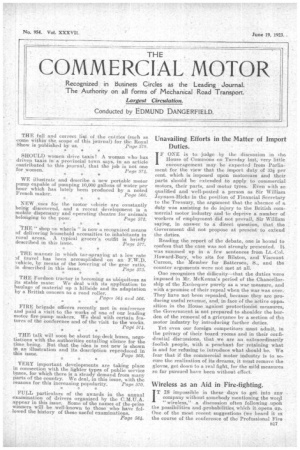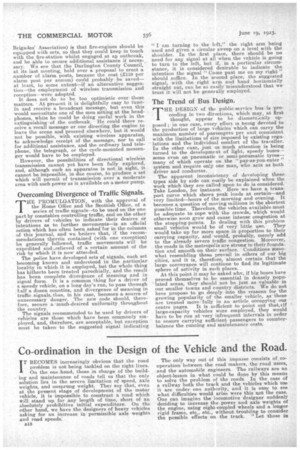Unavailing Efforts in the Matter of Import . Duties. .
Page 1

Page 2

If you've noticed an error in this article please click here to report it so we can fix it.
IF ONE is to. judge by the discussion in the House of Pounnons on Tuesday last, very little encouragement may be expected from Parliament for the view that the import duty of 33iper cent. which is imposed upOn motorcar and their parts should be extended to apply to commercial motors, their parts, and motor tyres. Even with so qualified and Well-posted a person as Sir William Joynson-Hicks in the position, of Financial Secretary to the Treasury, the argument that the absence of a duty was assisting to do injury to the British commercial motor industry and to deprive a number of workers of employment did not prevail, Sir William saying, in answer. to a direct question, that the , Government did not propose at present to extend the duties. .
Reading the report of the debate, one is bound to confess that the case was not Strongly presented. It was summed up in a. few sentences from Lt.-Col. .Howard-Bury, who sits for Bilston, and Viscount Curzon, the Member for Battersea, S., and the counter arguments were nbt met at .all. One recognizes the difficulty—that the duties were imposed in Mr. McKenna's period of the Chancellorship of the Exchequer purely as a war measure, and , with a'promise of their repeal when the war was over. The have not been repealed, because they are producing useful revenue, and, in face of the 'active opposition in the House against protectionist measures, the Government is not prepared to shoulder the burden of the removal of a grieuance by a section of tho motor industry by introducing further duties.
Yet even our foreign competitors must admit, in the privacy of their board rooms and in their confidential diseussions, that we are an extraordinarily foolish people, with a penchant for retaining what is and for refusing to introduce what should be. We fear that if the commercial motor industry is to secure the realization of its dreams, it must remove the gloves, get down to a real fight, for the mild measures so far pursued have been without effect.
Wireless as an Aid in Fire-fighting.
IT IS impossible in these days to get into any company without somebody mentioning the woril "wireless," a discussion often following upon the possibilities and-probabilities, which it opens UP. One of the most recent suggestions (we heard it in the course of the conference of the Professional Fire
Brigades' Association) is that fire-engines should be equipped with sets, so that they could keep in touch with the fire-station whilst engaged at au outbreak, and be able to secure additional assistance if necessary. We see that the Darlington County Council," at its last meeting, held over a. proposal to erect a number of alarm posts, because the cost (ill!) per alarm post per annum) could probably be saved— at least, to some extent—if an alternative suggestion—the employment of wireless transmission and reception—were adopted.
It does not do to be too optirnietic over these matters. ' At present it is delightfully easy to tunein and receive a broadcast message, but even this would necessitate one of the men sitting at the headphones, while he could be doing useful work in the extinguishing-of the outbreak. He could there receive a. recall message or one directing the engine to leave the scene and proceed elsewhere, but it would not be possible, with existing wireless apparatus, to acknowledge receipt of the message, nor to call for additional assistance, and the ordinary land telephone, the telegraph, or the cycle-mounted messenger would have to be employed..
However, the possibilities of directional wireless transmission cannot yet have been fully explored, and, although such an apparatus is not in sight, it cannot be impossible, in due course, to produce a set which will permit of transmission over a moderate area with such power as is available on a motor pump.
Overcoming Divergence of Traffic Signals.
THE PROMULGATION, with the approval of the Home Office and the Scottish Office, of a series of traffic signals—to be used on the one part by constables controlling traffic, and on the other by drivers of vehicles to indicate their desires Or intentions as to further movements—is an official action which has often been askedlor in the columns of this journal, and we believe that, if the recommendations therein contained (with one exception) be generally followed, traffic movements will be expedited and:relieved of a certain amount of the risk by which it is now attended.
The police have developed sets of signals, each set becoming known and understood in the particular locality in which it is employed, but the whole thing has hitherto been treated parochially, and the result has been complete divergence of meaning and in signal form. It is a common thing for a driver of a speedy vehicle, on a long day's run, to pass through halfa dozen counties, and divergence of meaning in traffic signals,. thus, in his case, becomes a source of unnecessary danger. The new code should, therefore, secure a much-desired uniformity throughout the country.
The signals recommended to be used by drivers of vehicles are those which have been commonly employed, and, therefore, are acceptable, but exception must be taken to the suggested signal indicating "I am turning to the left," the right arm being used and given a circular sweep on a level with the shoulder. In the first place, there should be no need for any signal at all when the vehicle is going to turn to the left, but if, in a particular circumstance, it is considered desirable to indicate the intention the signal "Come past me on my right" should suffice. In the second place, the suggested signal, with the right arm and hand horizontally straight out, can be so easily misunderstood that we trust it will not be generally employed.
The Trend of Bus Design.
HE DESIGN of the public-service bus .is -proceeding in two directions, which may, at first thought, appear to be diainetrieally opposed ; in one case, every effort is being devoted to the production of large vehicleswhich can carry the maximum number of passengers per unit. consistent with the limitations of size imposed by existing regulations and the individual comfort of the traveller. In the other ease, just as much attention is being turned to the development of light, speedy buses— some even on pneumatic or semi-pneumatic tyres— many of which operate on the "pay-as-you-enter" system and require only one man, who acts as both driver and conductor.
The apparent inconsistency of developing these types side by side can easily be explained when the work which they are called upon to do is considered. Take London, for instance. Here we have a transport curve which shows peak loads at certain—and very limited—hours of the morning and evening. It becomes a question of moving millions in the shortest possible time, Therefore, the vehicles available must be adequate to Dope with the crowds, which would otherwise soon grow and cause intense congestion at the stopping-points. In dealing with this problem small vehicles would be of very little use. They would take up far more space in proportion to their carrying capacity, and would, probably, merely add to the already severe traffic congestion. Moreover, the roads in the metropolis are strong in their foundation and smooth on their surface. Conditions somewhat resembling these prevail in others of our big cities, and it is, therefore, almost certain that the large conveyance will continue to find its legitimate sphere of activity in such places.
At this point it may be asked why, if big buses have proved themselves to be essential in densely populated areas, they should not be just as valuable in our smaller towns and country districts. We do not here propose to go deeply into the reasons for the growing popularity of the smaller vehicle, as these are treated more fully in an article occupying our
centre pages. It is sufficient to point out that,iif large-capacity vehicles were employed, they would have to be run at-very infrequent intervals in order to ensure carrying sufficient passengers to counterbalance the running and maintenance coats.




























